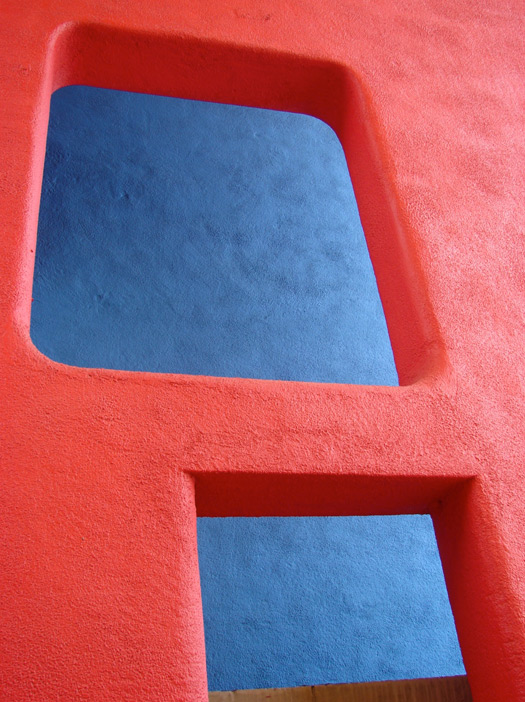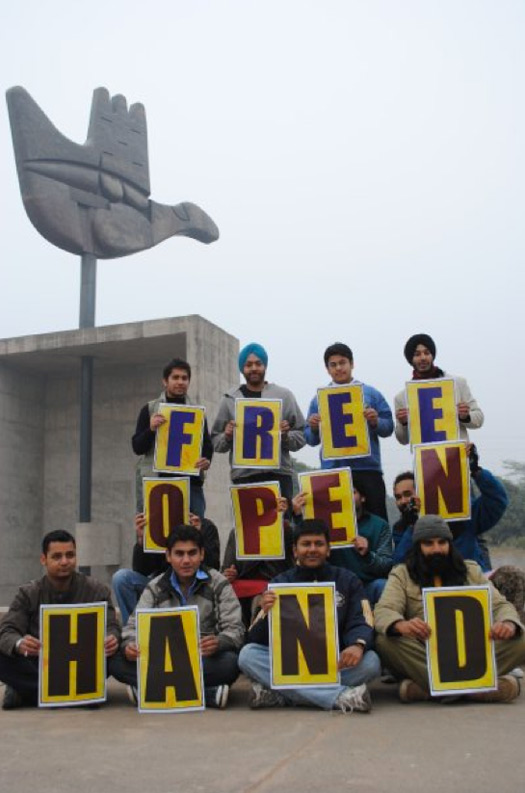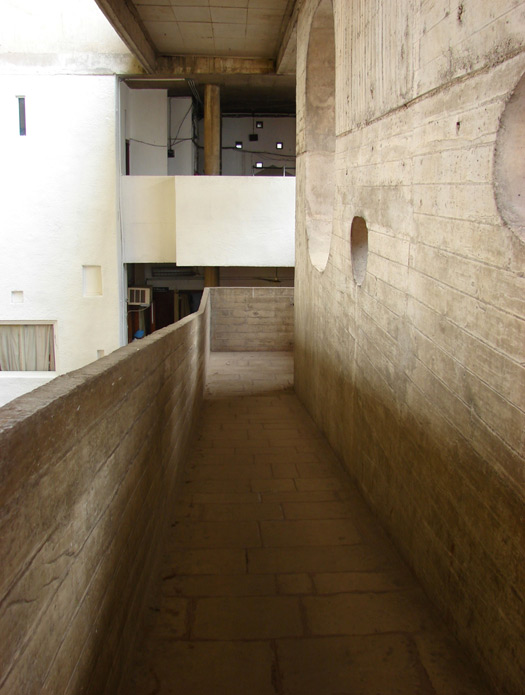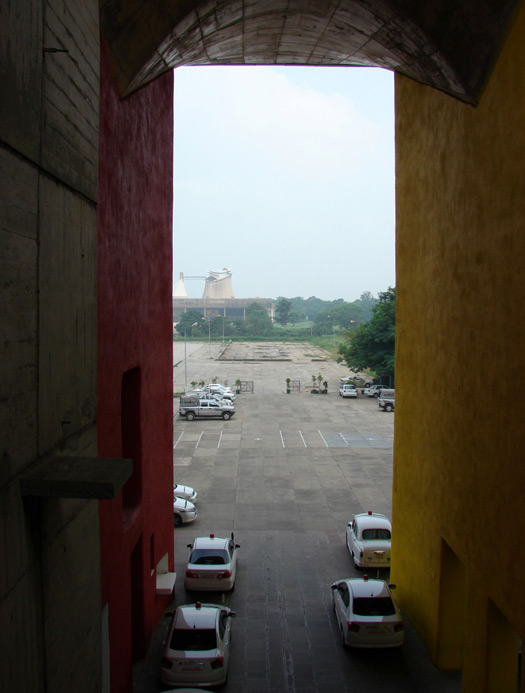
August 16, 2010
The Town That Corbusier Built

The Open Hand at Le Corbusier’s Capitol, Chandigarh, India. Photos: Ashish Nangia
When Le Corbusier, the Swiss-born visionary modernist architect, was commissioned in 1950 to build a new city on the baking plains of South Asia, his brief was to create one “free from the fetters of the past.” This phrase belonged to Jawaharlal Nehru, the forward-looking first prime minister of postcolonial India.
“I have welcomed greatly one experiment,” Nehru would say in 1959, “and that is Chandigarh…. It hits you on the head and makes you think.” Le Corbusier built the city in Punjab after Lahore, the region’s capital, was lost to Pakistan in the 1947 partition. The capitol complex, completed in 1960, housed a legislative assembly, high court, secretariat and landscape elements such as the Martyrs’ Memorial (a sculpture group symbolizing the British Empire’s defeat in India), Tower of Shadows (one of several structures in the area that pay homage to Punjab’s ferocious sun) and Open Hand (a monument that gives form to Chandigarh’s intended economic and cultural vitality). The capitol complex has been hailed as the epitome of modern architecture, though many argued that what postcolonial India really needed was food, shelter and employment for its masses.
While the world struggled with the Cold War, India experimented with a toned-down version of socialist enterprise. It grappled with and overcame numerous crises: famines, wars with neighbors, even a civil emergency. Little of the grisly politics seemed to penetrate to Chandigarh, an empty city with barren streets. And yet, that was to change. The years rolled on and the population increased, the town developed. People bought land, built houses and reveled in the urban plan: abundant green spaces, a panoramic view of the Himalayas, an artificial lake that brought succor in summer. Cars populated the wide roads and streets; institutions of education and research rose to nourish the denizens. Chandigarh’s town planning became an endeavor to be imitated, though the same has not been always true of its architecture. Le Corbusier’s modernist vision of his capitol was no match for political reality.

Part of the High Court, Chandigarh — a Cubist Painting?
For many years, though, the Open Hand was deserted, its surrounds used for cricket matches or as an occasional strolling ground by occupants of nearby villages. Of civic activity, there was none. The only regular visitors were architects and aficionados of Modernism, who came to gaze at this iconic anomaly in the middle of an empty landscape. More recently, a security-conscious local government barred visitors from the capitol who lacked official business there.

Activities at the Open Hand, Winter 2009
Today, however, Chandigarh’s citizens are beginning to wake up to this magnificent structure. A series of initiatives promises to bring life to the capitol and the Open Hand. Hum Log (“We the People”) is a citizens’ initiative working to “reclaim” the Open Hand by organizing street theater, debates and conferences at the venue. (On August 15, India’s Independence Day, it assembled townspeople for a group sing-along of patriotic songs.) Hum Log’s founder, Dr. Gaurav Chhabra, lays emphasis on the relationship of people with architecture, and on the importance of group action. “Participation,” he says, “is the essence. Once people start to participate, the rest follows.” He and his team have collected activists from around the city and beyond to highlight the monument and give visibility to its restricted access.
On January 29, 2010, their efforts paid off. Chandigarh’s government lifted the ban on social gatherings at the Open Hand and allowed it to be open to citizens daily between 10:30 and 3:30. Tourists and other outsiders, however, must still apply to the city’s administration for permission to visit, a burdensome stipulation that Chhabra believes undermines Le Corbusier’s vision.

Ramp at the High Court

View of the Capitol Buildings, Chandigarh
Sangeeta Bagga-Mehta, an associate professor at the Chandigarh College of Architecture, which is housed in a Le Corbusier–designed building, believes in working within the existing regulations to provide easier access for the growing number of visitors who make inquiries. “What has really changed Chandigarh’s position in the eyes of the world is its nomination for World Heritage status,” she says. Though the city’s 2006 placement in the “tentative” category of that elite list still remains to be approved, attention from UNESCO has produced a larger body of international visitors than ever before. Bagga-Mehta doubts that demonstrators at the Open Hand will persuade government officials to drop their security concerns. Rather she suggests that the capitol open a tourist information/interpretation office for issuing passes on the spot.
These days, on a Saturday, when courts are out of session and offices are closed, it is easy to visit the capitol, and even enter some of the buildings. The security apparatus is visible, and permits are still required for the more important buildings. But the capitol can be seen in its somewhat neglected state, a magnificent testament to modern architecture on a par with the Acropolis and Roman Forum. In the tussle over the question of who really “owns” the capitol — citizens or government — something vital has been neglected: the magnificent buildings themselves. It seems that finally Le Corbusier’s Open Hand, constructed for a city “free from the fetters of the past,” is fulfilling its purpose. Modern architecture is winning in this modern city in the most ancient of civilizations.
Observed
View all
Observed
By Ashish Nangia
Related Posts

Graphic Design
Sarah Gephart|Essays
A new alphabet for a shared lived experience

Arts + Culture
Nila Rezaei|Essays
“Dear mother, I made us a seat”: a Mother’s Day tribute to the women of Iran

The Observatory
Ellen McGirt|Books
Parable of the Redesigner

Arts + Culture
Jessica Helfand|Essays
Véronique Vienne : A Remembrance
Recent Posts
Mine the $3.1T gap: Workplace gender equity is a growth imperative in an era of uncertainty A new alphabet for a shared lived experience Love Letter to a Garden and 20 years of Design Matters with Debbie Millman ‘The conscience of this country’: How filmmakers are documenting resistance in the age of censorshipRelated Posts

Graphic Design
Sarah Gephart|Essays
A new alphabet for a shared lived experience

Arts + Culture
Nila Rezaei|Essays
“Dear mother, I made us a seat”: a Mother’s Day tribute to the women of Iran

The Observatory
Ellen McGirt|Books
Parable of the Redesigner

Arts + Culture
Jessica Helfand|Essays

 Ashish Nangia is an architect who specializes in the history of modern and Indian architecture.
Ashish Nangia is an architect who specializes in the history of modern and Indian architecture.